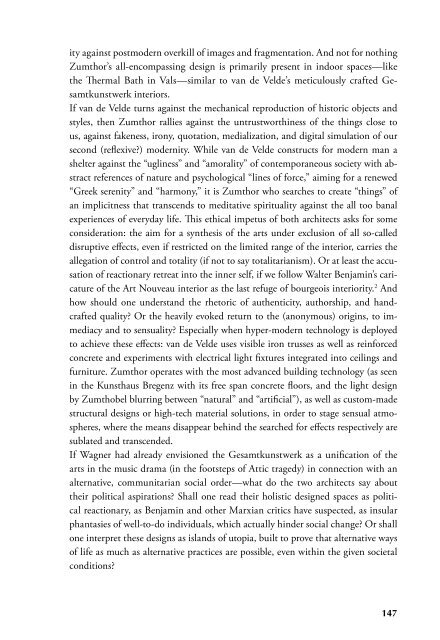The Death and Life of the Total Work of Art – Henry van de Velde and the Legacy of a Modern Concept
ISBN 978-3-86859-261-0
ISBN 978-3-86859-261-0
Create successful ePaper yourself
Turn your PDF publications into a flip-book with our unique Google optimized e-Paper software.
ity against postmo<strong>de</strong>rn overkill <strong>of</strong> images <strong>and</strong> fragmentation. And not for nothing<br />
Zumthor’s all-encompassing <strong>de</strong>sign is primarily present in indoor spaces—like<br />
<strong>the</strong> <strong>The</strong>rmal Bath in Vals—similar to <strong>van</strong> <strong>de</strong> Vel<strong>de</strong>’s meticulously crafted Gesamtkunstwerk<br />
interiors.<br />
If <strong>van</strong> <strong>de</strong> Vel<strong>de</strong> turns against <strong>the</strong> mechanical reproduction <strong>of</strong> historic objects <strong>and</strong><br />
styles, <strong>the</strong>n Zumthor rallies against <strong>the</strong> untrustworthiness <strong>of</strong> <strong>the</strong> things close to<br />
us, against fakeness, irony, quotation, medialization, <strong>and</strong> digital simulation <strong>of</strong> our<br />
second (reflexive?) mo<strong>de</strong>rnity. While <strong>van</strong> <strong>de</strong> Vel<strong>de</strong> constructs for mo<strong>de</strong>rn man a<br />
shelter against <strong>the</strong> “ugliness” <strong>and</strong> “amorality” <strong>of</strong> contemporaneous society with abstract<br />
references <strong>of</strong> nature <strong>and</strong> psychological “lines <strong>of</strong> force,” aiming for a renewed<br />
“Greek serenity” <strong>and</strong> “harmony,” it is Zumthor who searches to create “things” <strong>of</strong><br />
an implicitness that transcends to meditative spirituality against <strong>the</strong> all too banal<br />
experiences <strong>of</strong> everyday life. This ethical impetus <strong>of</strong> both architects asks for some<br />
consi<strong>de</strong>ration: <strong>the</strong> aim for a syn<strong>the</strong>sis <strong>of</strong> <strong>the</strong> arts un<strong>de</strong>r exclusion <strong>of</strong> all so-called<br />
disruptive effects, even if restricted on <strong>the</strong> limited range <strong>of</strong> <strong>the</strong> interior, carries <strong>the</strong><br />
allegation <strong>of</strong> control <strong>and</strong> totality (if not to say totalitarianism). Or at least <strong>the</strong> accusation<br />
<strong>of</strong> reactionary retreat into <strong>the</strong> inner self, if we follow Walter Benjamin’s caricature<br />
<strong>of</strong> <strong>the</strong> <strong>Art</strong> Nouveau interior as <strong>the</strong> last refuge <strong>of</strong> bourgeois interiority. 2 And<br />
how should one un<strong>de</strong>rst<strong>and</strong> <strong>the</strong> rhetoric <strong>of</strong> au<strong>the</strong>nticity, authorship, <strong>and</strong> h<strong>and</strong>crafted<br />
quality? Or <strong>the</strong> heavily evoked return to <strong>the</strong> (anonymous) origins, to immediacy<br />
<strong>and</strong> to sensuality? Especially when hyper-mo<strong>de</strong>rn technology is <strong>de</strong>ployed<br />
to achieve <strong>the</strong>se effects: <strong>van</strong> <strong>de</strong> Vel<strong>de</strong> uses visible iron trusses as well as reinforced<br />
concrete <strong>and</strong> experiments with electrical light fixtures integrated into ceilings <strong>and</strong><br />
furniture. Zumthor operates with <strong>the</strong> most ad<strong>van</strong>ced building technology (as seen<br />
in <strong>the</strong> Kunsthaus Bregenz with its free span concrete floors, <strong>and</strong> <strong>the</strong> light <strong>de</strong>sign<br />
by Zumthobel blurring between “natural” <strong>and</strong> “artificial”), as well as custom-ma<strong>de</strong><br />
structural <strong>de</strong>signs or high-tech material solutions, in or<strong>de</strong>r to stage sensual atmospheres,<br />
where <strong>the</strong> means disappear behind <strong>the</strong> searched for effects respectively are<br />
sublated <strong>and</strong> transcen<strong>de</strong>d.<br />
If Wagner had already envisioned <strong>the</strong> Gesamtkunstwerk as a unification <strong>of</strong> <strong>the</strong><br />
arts in <strong>the</strong> music drama (in <strong>the</strong> footsteps <strong>of</strong> Attic tragedy) in connection with an<br />
alternative, communitarian social or<strong>de</strong>r—what do <strong>the</strong> two architects say about<br />
<strong>the</strong>ir political aspirations? Shall one read <strong>the</strong>ir holistic <strong>de</strong>signed spaces as political<br />
reactionary, as Benjamin <strong>and</strong> o<strong>the</strong>r Marxian critics have suspected, as insular<br />
phantasies <strong>of</strong> well-to-do individuals, which actually hin<strong>de</strong>r social change? Or shall<br />
one interpret <strong>the</strong>se <strong>de</strong>signs as isl<strong>and</strong>s <strong>of</strong> utopia, built to prove that alternative ways<br />
<strong>of</strong> life as much as alternative practices are possible, even within <strong>the</strong> given societal<br />
conditions?<br />
147


















